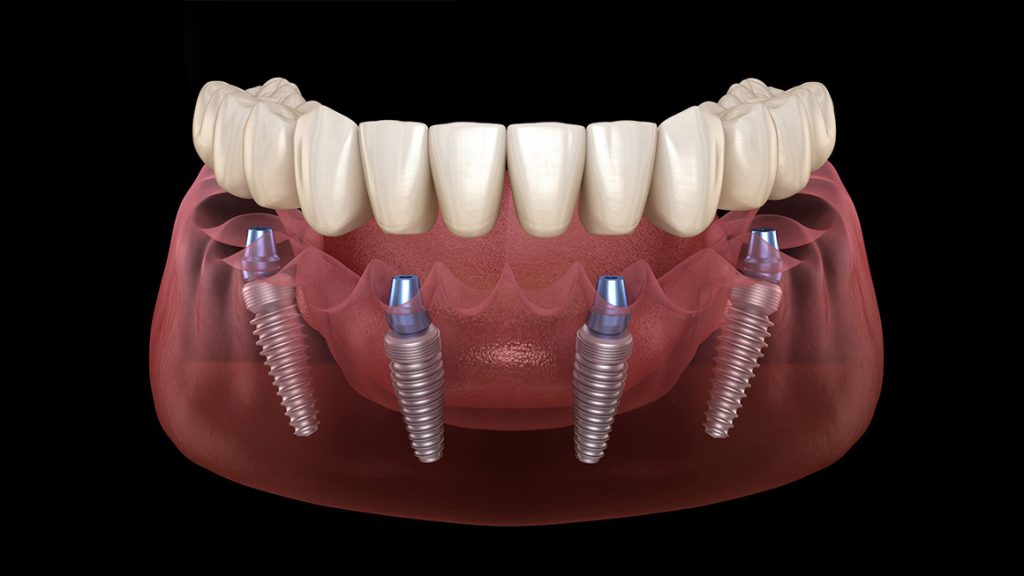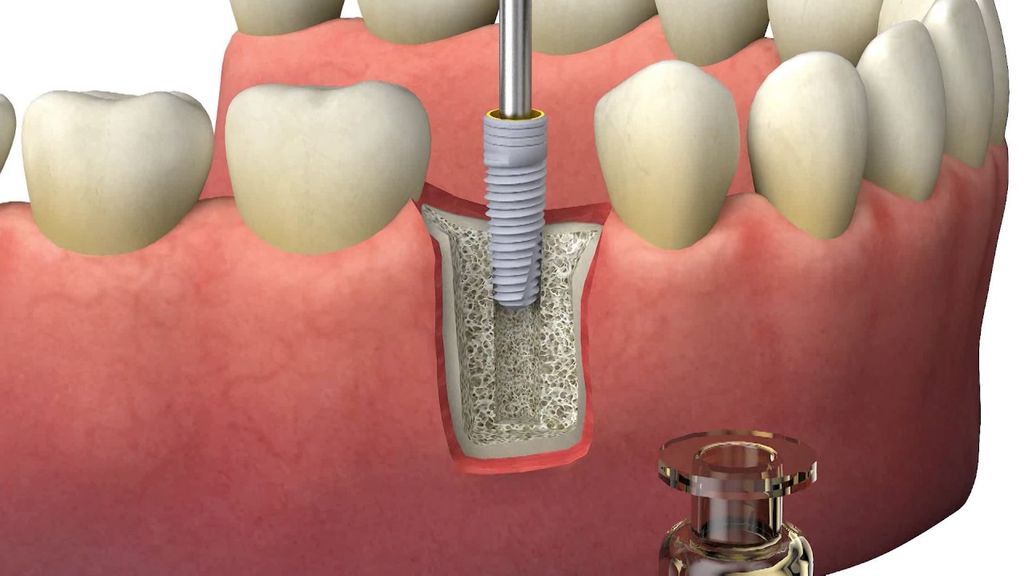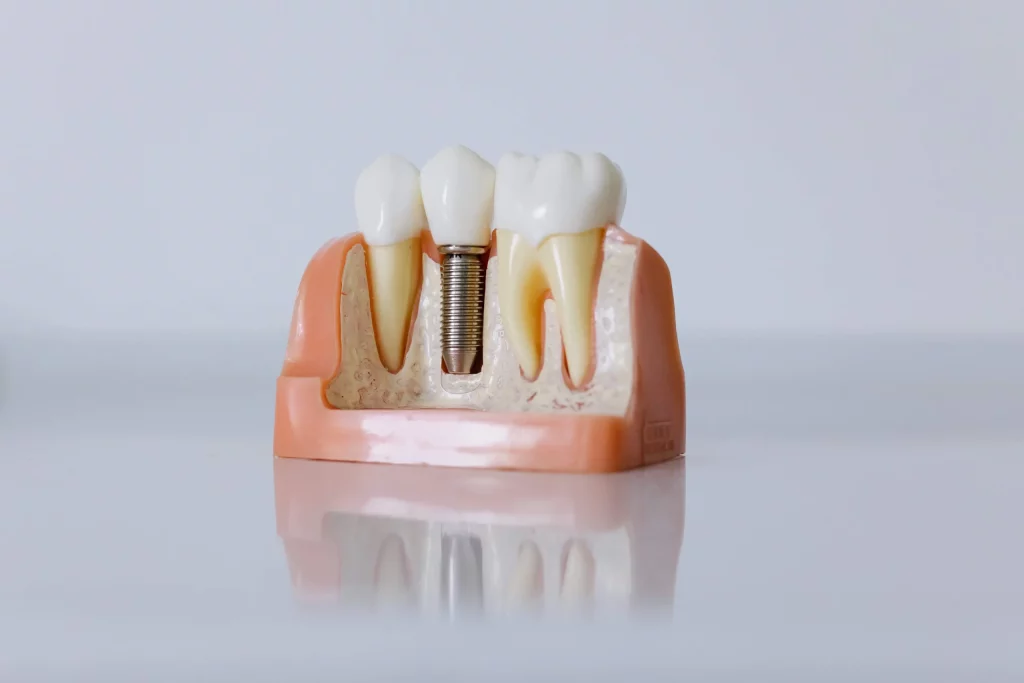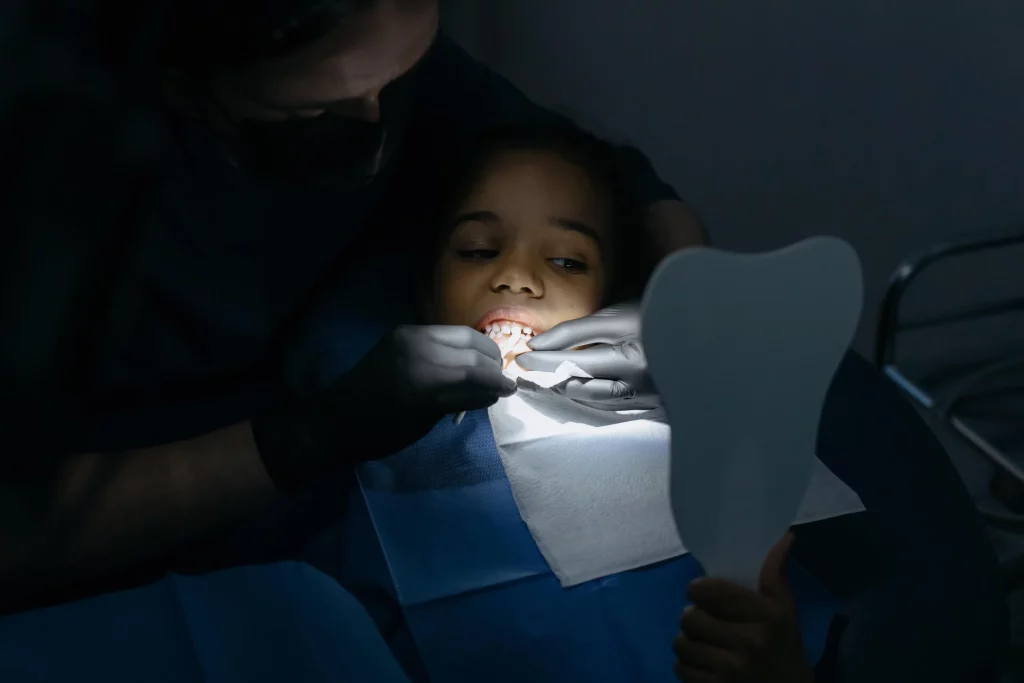Dental Implants
“EVERY MISSING TOOTH REDUCES YOUR QUALITY OF LIFE”
Our main goal is to keep your natural teeth. However, even when a single tooth is extracted, the natural balance is disrupted and the loss of teeth accelerates. In such cases, implants are a very special solution that provides the closest balance of force to your own teeth, allowing you to laugh beautifully and to eat with pleasure.
Dental implants are artificial tooth roots usually made of titanium or titanium compounds to replace the missing teeth.
Titanium is preferred as the material of choice for dental implants because of its resistance to forces and its capacity of not interacting with body tissues. Implants can be placed in cavities created by previously loss teeth or in the tooth socket immediately after extraction if there is no serious infection.
Implant
If the bone is sufficient and suitable to make fixed or removable prostheses, implants are placed in the jawbone with a simple operation. However, if the bone amount and density is not at the desired level, it may be necessary to perform bone formation procedures before placing the implants.
IMMEDIATE IMPLANT | INSTANT TEETH
Nowadays, our teeth play an extremely important role both from an aesthetic and functional point of view. For this reason, our priority should always be to keep our own teeth in our mouth. However, if our teeth need to be extracted, placing implants will be the best option.
In classical implant applications, a long time is needed to let the bone close the gap left by the extraction.
On the other hand, modern implantology allows us to place implants just after the extraction and, to a large extent, to attach a fixed tooth immediately.
The reason for waiting before implant placement after extraction is the possibility of contamination by inflammatory tissues on the implant surface and insufficient bone formation. However, studies have shown us that if the correct techniques are applied, immediate implant application produces correct results. Numerous literature studies on this subject support this view. When implant insertion is done in extracted or previously extracted healed sites with a certain scientific osseointegration torque value, fixed teeth (Immediate Loading) can be loaded on these implants immediately. There are also many scientific studies on this subject. In short, with the right planning and adequate application, people whose teeth are extracted will not experience edentulousness not even for a day.
In our daily life, we can use this solution in the following situations:
1) If all the teeth are extracted in the upper jaw or if there is complete edentulousness due to previous extractions, fixed teeth can be made immediately by planning an average of 6 implants according to the situation. A minimum of 4 implants are required for a fixed prosthesis in the upper jaw. The number of implants can be increased up to 8, depending on the width of the jaw curve, the application technique of the selected permanent tooth and the bone quality.
2) If all teeth are extracted in the lower jaw or if there is complete edentulousness due to previous extractions, fixed teeth can be made immediately by planning an average of 4 implants and fixed teeth can be made immediately. The number of implants can be increased up to 6, depending on the width of the jaw curve, the application technique of the selected permanent tooth and the bone quality.
3) If there is a reciprocal chewing area to be done in both jaws, fixed teeth can be placed immediately by applying at least 3 implants.
4) Fixed teeth can be inserted immediately in cases of tooth loss in the anterior region (the aesthetic area). In this case, the contact of the fixed teeth with the opposite ones should be avoided.
ALL ON FOUR | SIX
One of the main reasons why many people experiencing tooth loss (either because they have no teeth left or because of teeth extractions) cannot find a solution to this situation is the lack of time. All on four / six techniques offer an excellent solution to this problem.
In the All on Four / Six method, the extraction sockets are cleaned with laser as soon as the teeth are extracted, and the implant is placed immediately with fixed teeth placed on it. If there is no tooth, implants can be placed and prosthetic teeth can be fixed immediately.
In jaws that have been neglected for a long time for various reasons, bone loss caused by gingivitis, anatomical bone deficiencies (sagging sinuses in the upper jaw, superficial nerve bundles in the lower jaw, etc.), it is difficult to produce solutions using classical methods.
Anatomical structures in the lower and upper jaws are different in people who do not have any teeth, so the technique applied and the number of implants to be applied may also vary.
In the upper jaw;
– The surface area covered by the teeth is larger than the lower jaw.
– The jawbone is of lower density than the lower jaw, so the integration of implants with the bone becomes weaker and takes longer.
– Especially the upper jaw anterior region is aesthetically important.
– If the sinus is sagging in the posterior region, the support bone will be less, in this case either angled implants must be applied or short implants are used.
When all these factors are gathered together, the result of the static calculation performed by the physician is mostly over 6 implants (All on Six) in the upper jaw.
In the lower jaw;
– The tooth arch is smaller than the upper jaw.
– The jawbone density is higher and the implants can be fixed to the bone more firmly.
Prostheses made on 4 implants (All on Four) fixed to the posterior region implants and the two front implants, which are placed at an angle on the lower jaw nerve bundle, form the perfect abutment for a fixed over-implant prosthesis.
Who is the All on Four / Six applicable to?
We can apply this method with Staumann Proarch technique to all people whose general health condition allows implant application and who want immediate solutions after serial tooth extractions or in case of complete edentulism.
What advantages does implementing All on Four / Six offer?
– No need for advanced bone surgery
– We do not touch the original structures of the surrounding anatomy. (Like the sinuses)
– It is impossible for us to continue our life without having any teeth. This prevents the person from being unhappy and unsatisfied, without compromising one’s social life.
– Since fixed teeth are attached immediately, it is possible for us to eat just after the procedure.
– There is no difficulty in speaking as the teeth are attached immediately.
– If laser implant is applied, swelling and pain will be minimal after the procedure.
The All on Four system has been used for 27 years and its success has been proven in the literature.
In our clinic, the all on four/six technique of Straumann Implants has been applied for 14 years and its success has been confirmed by more than a thousand patients.

SEAMLESS IMPLANT
Implant applications performed without cutting gums and stitching are called “Seamless Implants”.
It can be done in three ways:
1- Three-dimensional image is processed in a computer program and with a guide plate (Static Navigation)
2- With new generation robot arms working with three-dimensional view (Dynamic Navigation)
3- By processing the three-dimensional image with the experience of the dentist performing the implant application and with the soft tissue acquisition thanks to laser gingival orientation.
In cases where the bone structure and anatomy are known in 3 dimensions and the bone thickness is suitable, the implant can be placed without cutting the gum. Only the implant insertion site is opened with laser and the implant is placed. Since the gingiva is not cut widely, there is no need for stitching and the blood circulation of the bone around the implant is not impaired because the gingiva does not separate from the bone. For this reason, since the bone and the gingiva are not traumatised, the patient experiences a comfortable and fast recovery without any additional pain and swelling.
GUIDED IMPLANTOLOGY
Guided implantology is a contemporary way of inserting dental implants in individuals who are missing a tooth or have just gotten their tooth removed. This method uses computers to scan the persons mouth and create a three-dimensional model that allows us to plan the ideal procedure before performing it. Guided dental implant surgery involves using high-tech imaging tools and machinery to aid or ‘guide’ them to manufacture and insert dental implants more precisely, accurately and efficiently. Guided implantology is becoming increasingly popular in dental practices.
What Does Guided Implantology Involve?
The first step in guided implantology is to perform an oral examination of the patient to check whether implants are an appropriate treatment. We will first scan your mouth using a dental CBCT and three-dimensional imaging techniques to assemble two-dimensional images into a 3D digital model. A CBCT scan collects essential information, including the position of sinuses, nerves, and other points of reference. We then use this model to plan the procedure and prepare a surgical guide to place the implant. After we have placed the crown, you will see a natural-looking tooth.
Why Should You Opt for Guided Implantology?
While experienced dentists can perform an implant procedure to create an aesthetically appealing result without the help of a computer, guided implant surgery significantly lowers the risk of human errors by planning the most efficient, safest procedure with the best-looking outcome. In addition, guided implantology enables the dentist to superimpose abutments and how much space will be required for the crown and any other structure that is going to be added.
IMPLANT TREATMENT IN BONE INSUFFICIENCY
In order to make healthy implant-supported teeth, implants should be held by at least 1 mm of tissues all around them. Therefore, sufficient width and length of bone support is needed to make long-lasting implants.
There are two basic methods for determining that there is enough bone:
1) Clinical examination by a knowledgeable and experienced physician
2) 3D imaging with dental volumetric tomography, where we can see all the details that cannot be detected during clinical controls and even during the operation
If it is determined that there is not enough bone to make a healthy prosthesis in the jaw, new bone formation can be made by applying different techniques in the jaws. Alternatively a healthy chewing can be achieved with correct prosthetic solutions by applying angled implants with the Straumann Proarch technique.
1) Sinus Lift Technique: If there is no bone in the posterior regions of the upper jaw, new bone formation can be achieved vertically in the sinus area.
2) Split Osteotomy (Sandwich Technique): It is the technique in which the implant is placed by opening the bone like a sandwich in insufficient bone thickness.
3) Block bone formation technique: It is applied by taking the block bone from the back of the jaw or hip and placing it in the missing area.
4) Box Technique: It is applied with artificial bone materials and thermoplastic molding technique.
Sinus Lifting
New Bone Formation Techniques
1) Sinus Lift Technique
Sinus lift or Sinus Augmentation is a surgical procedure that involves placing the bone in between the maxillary sinuses. It is an option for those lacking bone in the posterior regions of the upper jaw.
2) Split Osteotomy
Also called Sandwich Technique, split osteotomy is a bone manipulation technique used to prepare a site with insufficient bone thickness for the implant.
3) Block Bone Formation Technique
This jawbone reconstruction procedure involves taking block bone from the back of the jaw or hip and grafting it to the implant site. This technique is used for patients who have lost all or a significant amount of jawbone.
4) Box Technique
This procedure involves using artificial materials and a thermoplastic molding technique to build the jawbone for a dental implant.
IMPLANT SUPPORTED PROSTHESES
Teeth play an essential role in people’s quality of life. The main purpose of implants is enabling people to have high quality, functional and aesthetic teeth to be used when original teeth are lost.
For this purpose, prostheses applied with different techniques and materials and made with support from implants are called “Implant Supported Prostheses”.
1) Fixed Implant Prosthesis:
These are prosthesis that cannot be removed by the user in any way and are mostly preferred by the patients.
This type of prosthesis is almost always preferred in case of single or a small number of teeth missing.
They are mostly preferred in cases of complete edentulism, but in order to achieve successful fixed prostheses, the right conditions must be created and planning, material and technique must be selected correctly.
Fixed Implant Prostheses are Divided into Two:
a) Cemented (Adhered) Fixed Prostheses:
These prostheses are adhered on abutments which are screwed on implants. The basic logic of this feature is like crowns-bridges on the teeth. It cannot be removed by the patient, and when necessary, physicians cannot easily remove it.
To remove it, it is necessary to apply a blow or cut out the prosthesis. In case of complete edentulism, a minimum of 6 implants must be made.
Choice of material:
Metal supported porcelain crowns, zirconium supported porcelain crowns, monolithic zirconium and composite are used.
b) Hybrid (Screwed) Fixed Prostheses:
These prostheses are fixed to the abutments screwed to the implants. They are more preferred by physicians and patients every day. They cannot be removed by users, but can be easily removed and worn when desired by the physician. Thus, it can be removed when desired, the implant periphery maintenance can be done easily and fractures etc. problems can be easily repaired. In case of complete edentulism, a minimum of 4 implants are required.
Material of choice:
Metal-based zirconium porcelain materials can be used, but soft materials such as composite and enhanced acrylic are more preferred.
2) Removable Implant Supported Prostheses:
These prostheses are prostheses that are supported by both implants and palate, and that the wearer can remove and wear whenever they want. It is especially preferred in cases where the bone tissue is weak and implants can provide little support and when people may have difficulty reaching the implant periphery due to bone loss and cleaning the prostheses.
There are different attachment systems that support the prosthesis. According to this system, they are named as locator attachment holder, ball attachment holder, telescope attachment holder.
In the first examination of the selection of these prostheses, it is necessary to make a decision by examining and analyzing according to the bone structure, wishes, expectations and supporting tissues of the patient. Patients who have no teeth but have sufficient bone level can also use implant supported prostheses.
PERI IMPLANTITIS
Prevention and Treatment of Peri-Implantitis
The periodontitis of dental implants is sometimes called peri-implantitis. There is a growing number of implants in the medical world today. Dental implants can affect both the hard tissue as well as the soft tissue that surrounds it. These dental implants are made from foreign material, which may activate the immune system and lead to inflammation. When this inflammation occurs, it usually results in peri-implantitis. Peri-implantitis is harmful as it can lead to a lack of osseointegration necessary for the implant to do its job.
What is Peri-Implantitis?
It is a condition that mainly affects those who have recently received a dental implant. It may begin as bacteria which can settle around the implant. In the beginning, it looks like gum disease, which can majorly cause harm to the gums and teeth. Dental implants don’t always equate to peri-implantitis. You can easily avoid any situation with this disease if you are careful. The symptoms initially are not harsh. You will witness swollen gums along with some sensitivity in your mouth. The key to this disease is preventing it, diagnosing it, and treating it.
How to Prevent Peri-Implantitis?
There are certain ways to prevent peri-implantitis. We have mentioned some of these ways below:
Clean Implants Thoroughly
When you get an implant, you must ensure that you take proper care of it. Cleaning implants is not as easy as cleaning teeth. You may want to visit your dentist twice a year so that they can help you clean out your implants in a better way.
Have Good Dental Hygiene
You should brush and floss your teeth at least twice a day so that there are no food pieces between your implants for bacteria to attack. We suggest that you use a mouth rinse to upkeep the guard in your mouth. Ensure that you’re eating healthy and avoiding too much sugar, at least during the first few weeks of getting the implant. The implant is weakest when it’s just been installed, so you must be more careful in the beginning.
Restrict Your Smoking Consumption
Smoking leads to a lot of diseases. If you smoke, your body’s immune system gets weaker at identifying and fighting simple bacteria. Smoking is directly related to more significant concerns in mouth health, so restricting your cigarettes or smoking intensity can help prevent this disease.
Peri-Implantitis Symptoms: How to Diagnose Peri-Implantitis?
Some significant symptoms inform you that you may have peri-implantitis:
- There may be inflammation if there is redness and swelling in your gums around the implant.
- If you have a receding gum line near the implant, this may be the cause of concern.
- Clear visibility of threads around the implant.
- If there’s any discharge from the soft tissue around the implants.
- If there is extended pain near the bone or soreness around the jawbone, you may have peri-implantitis.
- Lymph nodes around the neck or armpits seem swollen or tender to touch.
Peri-Implantitis Treatment: How to Treat Peri-Implantitis?
There are many ways that peri-implantitis can be treated. We have mentioned the major ways below:
Antibiotics
If bacteria persist within the gums and bone around the implant, antibiotics can help kill them. These antibiotics can also be applied on the implant all on their own to prevent further implantitis.
LAPIP Treatment
It is one of the most effective ways to kill bacteria without harming the tissue. LAPIP, or Laser-Assisted Perio Impanititis Protocol, uses a small laser that can fit between the implant and the gums. The laser is smart enough to differentiate between benign and malignant bacteria. It is a non-invasive procedure, so recovery is effortless.
Surgery
If the peri-implantitis is extreme, then there is a need to remove the implant. To remove the implant, the dentist must open your gums and completely clean them to eliminate the infection. A new bone can then be grafted and placed alongside your implant. This treatment is often used alongside antibiotics so that infections do not persist.
Prostheses
The Types and Advantages of Dental Prostheses
Dental Prostheses are being used all over the world. A perfect smile that shines through is exceptionally important to people today and the increase in dental procedures is a clear sign of this. The dental prosthesis is a dental device used on the patient’s teeth to ensure that they can hide any imperfections. These devices also keep your teeth well-maintained and functional.
Prosthetic teeth and maxilla facial prostheses are growing increasingly common now due to the increased disposable income in the global population. The increased demand has led to greater demand and thus the creation of dental prostheses.
Dental Prosthetics have two major categories: removable dental and non-removable dental prostheses. Different types of dental prostheses fit these categories.
Types of Dental Prostheses
Removable Dental Prostheses
These types of dental prostheses are ones that the patient can remove when they’re not in use. Types of removable dental prostheses include:
1. Total Plate
The entire plate is for all the patients who no longer have any part of their dentition. Dentures that are majorly used for the elderly come under this category. The total plate consists of a base generally made using a synthetic material like nylon with teeth fixed.
2. Clasp Dental Prosthesis
These dental prostheses are one of the most comfortable to wear. They involve two segments of dental prostheses which are connected by a metallic wire. They fit into the mucus lining of the teeth with relative ease, making wearing these dental prosthetics extremely easy.
3. A Partial Dental Prosthesis
This prosthesis doesn’t have a full plate and instead has metal clips that attach to other parts of the teeth. The partial dental prosthesis is for all patients with a certain number of teeth.
Non-Removable Dental Prostheses
Non-removable dental prostheses remain firmly attached to the patient’s mouth and can only be replaced or removed by a skilled dentist. Types of non-removable dental prostheses include:
1. Dental Bridges
Dental bridges are prosthetic devices used when the patient is missing several teeth in a row. There is a significant sharpening of other teeth on the side, so the bridge in the middle can be made.
2. Dental Crowns
Dental crowns are used to provide a new covering for a damaged tooth. This dental prosthetic helps to ensure that your original tooth isn’t lost. Crowns are a relatively permanent solution. However, they’re certainly not completely permanent, as there are many times that these prosthetics have to be replaced.
3. Dental Implant
Dental implants are prosthetic devices that are screwed into the jawbone. These provide a location for the tooth to rebuild. It’s a solution that helps with missing teeth, as these can be pretty difficult to treat otherwise.
Advantages of Dental Prostheses
1. They Help in Supporting Partial Dentures
Throughout your life, you’ll need dentures in some way, shape, or form. Having dental prostheses will help you support the rest of the partial dentures around you,
2. They Have Less Bone Loss
You are also much more likely to lose bones when you lose teeth. Dentures don’t provide the kind of support to the jaw bone that dental prostheses do, which is why they are better for your jaw bone.
3. They Make You Look Better
As we move into a world of social media, we understand that looks matter increasingly. Having a nice smile is important to people now, and it adds to a person’s confidence.
4. Better Quality of Living
Having good teeth means that you will be able to eat better food and even digest it better. It ensures that you have better gut health moving forward.



